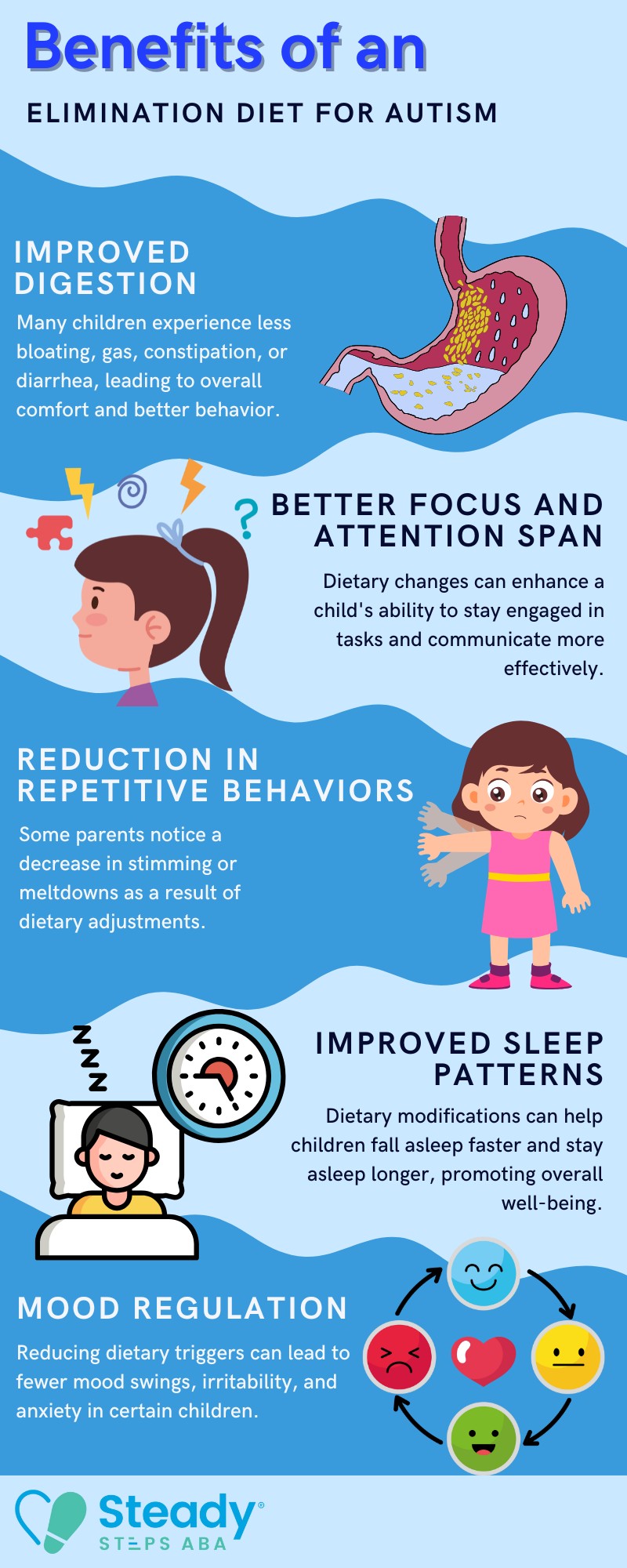Key Points:
- An elimination diet for autism often removes gluten and casein to assess whether symptoms improve.
- Some families report changes in behavior, digestion, and attention, although scientific results are mixed.
- Careful planning and professional guidance are essential to ensure the diet is safe and nutritionally complete.
Approximately 11.25% of children with autism experience some type of food allergy. This indicates the importance of careful feeding techniques, including specific diet plans.
An elimination diet for autism is a structured eating plan that removes specific food ingredients—often gluten and casein—to observe their potential effect on autism-related symptoms. These ingredients are then slowly reintroduced to identify any behavioral or physical reactions.
Parents who choose this approach are often looking for non-medication strategies to support their child’s well-being. While the results vary widely, some families have reported improvements in areas like focus, digestion, language, and even sleep.
In this article, we’ll dive deep into elimination diets for autism, including some examples and useful tips you can implement to ensure your child’s success.
Why Do Families Try Gluten-Free, Casein-Free Diets for Autism?
Many families turn to dietary changes after noticing links between their child’s food intake and behavioral shifts. Children on the spectrum frequently experience gastrointestinal issues like constipation, diarrhea, or bloating—issues that may be triggered or worsened by gluten and casein.
The theory behind the gluten-free, casein-free (GFCF) diet suggests that these proteins may not break down properly in the gut for some children. In those cases, partially digested peptides may enter the bloodstream and potentially affect brain function, acting similarly to opiates in the brain. This concept is still debated, but anecdotal reports have led many to explore dietary intervention.
Additionally, food intolerances and sensitivities may increase inflammation or contribute to sensory discomfort, making a child more reactive or withdrawn.
The Surprising Benefits of an Elimination Diet for Health Improvement
While not every child responds to dietary changes, some families report noticeable shifts within weeks of removing gluten and casein. These changes tend to be subtle at first and may become more pronounced over time if the child is indeed sensitive to these proteins.
Reported benefits from a GFCF or elimination diet for autism include:

Again, these outcomes are not guaranteed, but they are compelling enough for many parents to explore this strategy under medical guidance.
4 Potential Risks of Starting an Elimination Diet
An elimination diet for autism requires careful planning. Simply removing entire food groups—especially dairy and grains—can lead to nutritional deficiencies if not replaced with proper alternatives.
Before beginning, it’s essential to consult with a pediatrician, dietitian, or nutritionist familiar with autism and dietary interventions. Professionals can help ensure that the diet is balanced and sustainable.
Possible risks of poorly managed elimination diets include:
1. Calcium and Vitamin D Deficiency
When dairy is eliminated without a proper substitute, it can lead to a deficiency in calcium and vitamin D. These nutrients are essential for bone health, and lacking them can impact growth and development.
2. Iron or Fiber Deficiency
Removing whole grains or iron-rich foods without adding replacements can lead to deficiencies in iron and fiber. These nutrients are crucial for energy levels, digestion, and overall health.
3. Excessive Restriction
Excessively limiting food choices can create unnecessary anxiety around eating, especially in picky eaters. Over-restriction can worsen food aversions and make it harder for children to build a healthy relationship with food.
4. Nutritional Gaps Affecting Growth and Development
When a child’s diet lacks key nutrients, it can affect their growth trajectory and overall development. Monitoring and balancing their diet ensures they receive the necessary vitamins and minerals for optimal health.
The key is not to eliminate foods blindly, but to approach the diet scientifically, with baseline tracking, supervised changes, and slow reintroductions. This approach aligns with the insights shared in our article Feeding Disorder in Autism: Causes, Symptoms & Support, where we explore the underlying factors of feeding difficulties and provide practical guidance for parents and caregivers.
How To Start an Elimination Diet Safely
Starting an elimination diet for autism doesn’t mean overhauling everything overnight. The goal is to go slow, be observant, and document everything. The clearer your notes, the easier it is to determine whether changes are helping.
Steps to begin an elimination diet for autism include:
- Keep a food and behavior journal for at least 1–2 weeks before making changes. Log meals, bowel movements, sleep, and mood.
- Remove one protein at a time, starting with gluten or casein, not both at once.
- Monitor changes for 4–6 weeks while maintaining the diet.
- Slowly reintroduce the eliminated food after the trial period to see if symptoms return.
- Work with a registered dietitian to ensure nutrients are replaced appropriately.
Consistency is key. Cross-contamination can make it difficult to assess results, so full commitment and careful label reading are necessary.
Understanding the Common Sources of Gluten and Casein in Diets
For many parents, the hardest part of starting a GFCF diet is identifying all the hidden sources of gluten and casein. These proteins appear in more than just bread and milk—they often sneak into processed foods, sauces, and even supplements.
Common foods that contain gluten include:
- Bread, bagels, pasta, crackers, and cereals
- Battered or breaded meats and fish
- Soups, gravies, and sauces (often thickened with wheat)
- Some soy sauces and salad dressings
Common foods that contain casein include:
- Milk, cheese, yogurt, butter, and cream
- Ice cream and custards
- Whey and casein protein powders
- Processed meats and deli products (sometimes contain milk-derived binders)
Look for certified gluten-free and dairy-free labels, but also double-check ingredients for hidden terms like “modified food starch,” “hydrolyzed protein,” or “milk solids.”
Exploring Which Foods are Safe on a GFCF Diet
Despite restrictions, there are still many delicious and nutritious foods that can be safely included on a GFCF elimination diet for autism. With creativity and variety, meals can remain enjoyable and balanced.
Some GFCF-friendly food options include:
- Fruits and vegetables: All fresh produce is naturally gluten- and casein-free.
- Proteins: Eggs, poultry, beef, tofu, beans, and legumes.
- Gluten-free grains: Rice, quinoa, oats (certified GF), millet, and corn.
- Dairy alternatives: Almond milk, coconut milk, oat milk, or rice milk.
- Snacks: GFCF granola bars, fruit leathers, veggie chips, and homemade baked goods with alternative flours.
- Healthy fats: Olive oil, avocado, nut butters (if tolerated), and seeds.
Try to build meals around whole foods rather than relying entirely on packaged alternatives, which may be highly processed.
Can an Elimination Diet Be Combined With ABA Therapy?
Yes. In fact, many families find that combining an elimination diet with ABA therapy offers more comprehensive support. ABA focuses on behavior, helping children build functional skills, regulate emotions, and reduce challenging responses.
When dietary changes lead to increased attention, improved sleep, or reduced GI distress, ABA sessions can become more effective. Likewise, ABA strategies can assist with:
1. Expanding Accepted Food Choices
Gradually introducing a wider variety of foods can help children expand their accepted food options. This approach is key to improving overall nutrition and reducing mealtime stress over time.
2. Teaching Tolerance for New Textures or Tastes
Helping children gradually accept new textures or flavors builds their comfort and flexibility with food. Small steps, like introducing similar textures or familiar flavors in new dishes, can make this process more manageable.
3. Reinforcing Appropriate Behavior During Mealtime
Encouraging positive behaviors, such as sitting calmly or trying a new food, is key to building good mealtime habits. Positive reinforcement, like praise or rewards, helps strengthen these behaviors and makes mealtime more enjoyable.
4. Reducing Anxiety Around Food Changes
Introducing food changes slowly, without pressure, helps reduce anxiety and build trust in the eating process. By providing a calm, predictable environment, children are more likely to feel confident about trying new things.
The collaboration between behavior specialists and dietary professionals allows for a well-rounded plan tailored to the child’s needs.
Transform Your Child’s Future with Personalized ABA Therapy
If you’re considering an elimination diet for autism and want help building behavioral routines, Steady Steps ABA can support your journey. We offer ABA therapy in Maryland, helping families understand, manage, and improve everyday life for children with autism—whether that involves food transitions, communication challenges, or sensory sensitivities.
ABA can complement dietary interventions by providing structure, positive reinforcement, and support strategies that make these changes more manageable for both you and your child.
Reach out to us today to learn how our ABA therapy in Maryland can support your family’s health, behavior, and mealtime routines—one step at a time.






